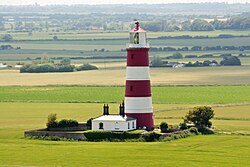Happisburgh Lighthouse
| Happisburgh Lighthouse Hasborough | |||
 Happisburgh Lighthouse | |||
|---|---|---|---|
| Location | |||
| Location: | Happisburgh | ||
| Location: | 52°49’14"N, 1°32’13"E | ||
| Characteristics | |||
| Height: | 85 ft | ||
| Tower shape: | Cylindrical tower with balcony and lantern | ||
| Tower marking: | Tower with red and white bands, white lantern, red lantern roof | ||
| Light: | Fl (3) W 30s | ||
| Focal height: | 134 ft | ||
| Range: | 14 nmi | ||
| Light source: | Mains power | ||
| Admiralty No.: | A2336 | ||
| History | |||
| Built 1791 | |||
| Information | |||
Happisburgh Lighthouse in Happisburgh on the north Norfolk coast is the only independently operated lighthouse in Great Britain. It is also the oldest working lighthouse in East Anglia.
History
The building was constructed in 1790 as one of a pair of candle-powered lights ("High Lighthouse" and "Low Lighthouse").[1] In 1801 candle power gave way to oil lamps and reflectors. In 1863 the lantern stage (the top-most part of the tower) was replaced with the diagonally-framed glass structure seen today (which was a new innovation at the time). Coal gas (produced on site) replaced oil as the light source in 1865,[2] and three years later the reflectors were replaced in each lighthouse by a large (first-order) catadioptric lens designed by James Chance.[3] The light source was changed to paraffin in 1910, and then to an automated acetylene system in 1929; this meant that there was no further need for keepers to be permanently accommodated on site, and the keepers' cottages were then sold.[2] In 1947 the light was electrified and given a new group flashing characteristic: three flashes ever 30 seconds.[2]
The tower is 85 ft tall, putting the lantern at 134 ft above sea level.[4] The lighthouse is painted white with three red bands and has a light characteristic of Fl(3)30s (three white flashes, repeated every 30 seconds) at a height of 135 ft with a range of 14 nautical miles.[5] It continues to use the optic installed in 1868.
The other lighthouse - the "low light" - was 20 ft lower. Together they formed a pair of range lights that marked a safe passage around the southern end of the offshore Haisborough Sands eight miles to a stretch of safe waters known as 'The Would'.[6] In 1871 Happisburgh's lighthouses were used for a series of trials comparing an oil light (displayed from the low lighthouse) with gas light (displayed from the high lighthouse) both using the same optics;[7] the experiments (which tested rival claims made by the principal advocates of these forms of illumination, James Nicholas Douglass and John Richardson Wigham respectively) were not conclusive and further trials later took place at South Foreland.
The low light was decommissioned and demolished in 1883 before it could be lost due to coastal erosion; its lantern and lens were reused at Southwold lighthouse.[8] The demolition of the low light led to the High Light being repainted with red bands, so as to differentiate it more clearly from the lighthouse at Winterton; at the same time it was also provided with an occulting mechanism to differentiate the light itself.[2]
Independence
In 1987 Happisburgh was one of five lighthouses declared redundant by Trinity House and deactivation was planned for June 1988. Villagers organised a petition to oppose the closure, and as a result the date was postponed.
Under the Merchant Shipping Act of 1894,[9] Trinity House may dispose of a working lighthouse only to an established Lighthouse Authority. On 25 April 1990 the Happisburgh Lighthouse Act[10] received the Royal Assent establishing the Happisburgh Lighthouse Trust as a Local Light Authority, and Happisburgh became the only independently run operational lighthouse in Great Britain.
In popular culture
- The lighthouse was used as the location for the video of Ellie Goulding's 2010 song "The Writer".[11]
- It features prominently in the 2015 horror film AfterDeath, its beam causing terrifying flashbacks.
Bibliography
- Price Edwards, E. (2010). Lighthouse(1884). BiblioBazaar. ISBN 1-146-41637-7.
- Golding CBE, Capt. Thomas (1929). Trinity House from Within. private printing.
- Hague, Douglas B.; Christie, Rosemary (1975). Lighthouses - Their Architecture, History and Archaeology. Llandysul : Gomer Press. ISBN 0-85088-324-5.
- Long, Neville (1983). Lights of East Anglia. Terence Dalton Ltd.. ISBN 0-86138-029-0.
- Stevenson, D. Alan (1959). The World's Lighthouses Before 1820. Oxford University Press.
References
- ↑ "Map of Norfolk". http://www.british-history.ac.uk/mapsheet.aspx?compid=55129&sheetid=5983&ox=2925&oy=2631&zm=2&czm=2&x=393&y=277. Retrieved 2016-04-13.
- ↑ 2.0 2.1 2.2 2.3 "A Brief History of Happisburgh Lighthouse". http://www.happisburgh.org/lighthouse/history. Retrieved 24 February 2019.
- ↑ Chance, James Frederick (1902). The Lighthouse Work of Sir James Chance, Baronet. London: Smith, Elder & co.. p. 166. https://uslhs.org/sites/default/files/attached-files/The%20Lighthouse%20Work%20of%20Sir%20James%20T.%20Chance.pdf. Retrieved 24 February 2019.
- ↑ "Lighthouses of the World & Fog Signals" - Alexander Finlay, Richard Holmes Laurie, 1888
- ↑ "Happisburgh Lighthouse". http://www.happisburgh.org/lighthouse. Retrieved 2016-04-13.
- ↑ Happisburgh Village Website - History of Happisburgh Lighthouse
- ↑ Elliot, George H. (1875). European Light-House Systems. London: Lockwood & co.. p. 104-113. http://access.bl.uk/item/pdf/lsidyv38f8413f. Retrieved 10 March 2019.
- ↑ Point 2 - The Lighthouse, BBC Suffolk. Retrieved 2012-10-29.
- ↑ Merchant Shipping Act of 1894, part XI (p. 260 of the PDF version)
- ↑ Happisburgh Lighthouse Act as annotation C9 modification of Merchant Shipping Act of 1894
- ↑ "The Writer... prochain single d'Ellie Goulding.". news-de-stars.com. 21 June 2010. Archived from the original on 13 July 2010. https://web.archive.org/web/20100713022948/http://www.news-de-stars.com/musique/the-writer-prochain-single-d-ellie-goulding_mrm90085.html. Retrieved 3 July 2010.
Outside links
| ("Wikimedia Commons" has material about Happisburgh Lighthouse) |
- Happisburgh Lighthouse website
- Trinity House Lighthouse Service
- An 1892 OS map, showing both the Happisburgh lighthouses ('England - Norfolk: 030/NW', Ordnance Survey 1:10,560 - Epoch 1 (1892)). Date accessed: 28 August 2010
